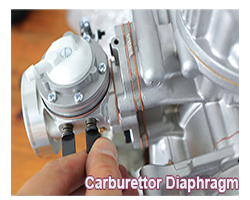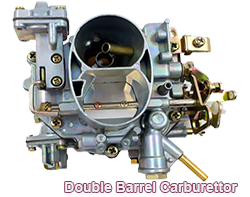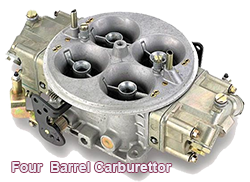
DECELERATION FUEL CUT-OFF: Describes a device that stops the flow of fuel to the carburettor or injectors when the vehicle rapidly decelerates in the event of an accident, preventing the possibility of a fire or explosion.
DETONATION: Describes the fuel charge's action burning too violently, sometimes resulting in a sound called "pinging."
DIAPHRAGM: Describes a flexible cloth-rubber sheet stretched across an area, thereby separating two different compartments, is used in pumps to create a pressure differential liable to cause any fluid to be pushed or pulled from one point to another
DISCHARGE CHECK BALL: Describes a small check ball found in a carburettor that lifts off its position when the pump well is pressurised by the accelerator pump, allowing fuel to be discharged into the venturi through the shooter nozzle
DISCHARGE NOZZLE: Describes the end of the main delivery tube that discharges fuel into the venturi area of a carburettor.
DIVORCED CHOKE: Describes a vacuum diaphragm mounted on the carburettor where the choke lever is operated by a mechanical linkage rod from the bimetal spring. Sometimes described as a remote choke.
DOUBLE-BARREL CARBURETTOR: Describes the two throttle openings or barrels from the carburettor to the intake manifold.
DOWNDRAFT CARBURETTOR: Describes a carburettor in which the air passes down into the intake manifold.
DRY SETTING: Describes the act of adjusting the float with a graduated rule while the carburettor is disassembled on the bench.
ENRICHMENT UNIT: Describes a circuit in a carburettor set to provide a richer mixture-the unit is operated through engine vacuum
ENRICHNER: Describes a type of fuel plunger used in a carburettor in place of a choke. By activating the plunger, more gas is permitted into the intake area to enrichen the fuel-air mixture for easier starting.
FAST IDLE CAM: Describes a cam in a carburettor that opens the throttle slightly when the choke is brought into operation.
FAST IDLE SCREW: Describes a screw on a carburettor used to adjust the fast idle's speed.
FEEDBACK CARBURETTOR(FBC): Describes a carburettor regulated by a closed-loop system (computer, solenoid-controlled valve, catalytic converter, oxygen sensor, among others,) providing and adjusting the air-fuel mixture quality to operate a catalytic converter
FEEDBACK CARBURETTOR ACTUATOR: Describes a computer-controlled stepper motor that varies the carburettor air/fuel mixture.
FEEDBACK CONTROL: Describes a closed-loop control.
FEED PIPE: Describes a pipe that supplies liquid or gas.
FIXED-CHOKE CARBURETTOR: Describes s carburettor where the choke tube or venturi is of predetermined size.
FIXED-JET CARBURETTOR: Describes the most common type of carburettor in which the jets and choke are of a predetermined size.
FLOAT LEVEL: Defines the height of the fuel in the carburettor float bowl.
FLOAT NEEDLE: Describes a needle in the carburettor activated by fuel level in the float bowl.
FOUR-BARREL CARBURETTOR: Describes a carburettor, usually found on large V-8 engines, with four barrels that operates like dual carburettors, with the second carburettor (third and fourth barrels) cutting in only at high speeds.
All Categories
- Home Page
- Mechanics
Mechanics
Back- Camshaft
- Carburettors A-C
- Carburettors D-F
- Carburettors H-M
- Carburettors R-W
- Clutch B-C
- Clutch D-W
- Cooling System A-C
- Cooling System D-F
- Cooling System H-W
- Crankshaft A-C
- Crankshaft D-W
- Cylinder Head
- Engine A-D
- Engine E
- Engine F-L
- Engine M-S
- Engine T-X
- Filters
- Fuel Control Systems A-E
- Fuel Control Systems F
- Fuel Control Systems M-S
- Gearbox A-D
- Gearbox E-G
- Gearbox H-R
- Gearbox S-W
- Oil Control Systems C-W
- Oil Control Systems
- Pistons
- Auto Electrics
- Brakes,Suspension and Steering
Brakes,Suspension and Steering
Back- Axles
- Brakes A-B
- Brakes E-D
- Brakes FL
- Brakes M-R
- Brakes S-Y
- Differential
- Drive Systems
- Exhaust Systems A-D
- Exhaust Systems E
- Exhaust Systems F-Y
- Hydraulics
- Shock Absorbers
- Springs
- Steering A-R
- Steering S-V
- Suspension A-H
- Suspension I-R
- Suspension S-W
- Tires A-F
- Tires G-B
- Tires S-W
- WheelsA-I
- WheelsI-S
- Wheels T-V
- Bodywork
- Exterior Trim
- Interior Trim
- Paintwork
- Parts and Fittings
- Tools and Equipment
Tools and Equipment
Back 



- Site Map
- Privacy Policy
- Contact Us


Step back in time to the renaissance age of the UK and European Car Industries
All that is happening NOW in the world of classic cars.
Step into the golden decade of the UK and European Car Industries
Got a question, a comment, a suggestion or an offer??? - FEEL FREE TO CONTACT US ANYTIME!!
Catch up with all the latest news and features.
Sign up for a Classic Car Info Twitter account.
All you need to know on how to acquire, restore and maintain a Classic Car
ae4









